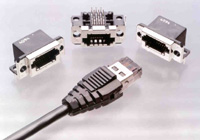 Photo ©1998 AMP INC.
Photo ©1998 AMP INC.While there are several test methods to determine susceptibility to SCC, that detailed in ASTM G37, using Mattsson's solution and moist ammonia, is widely used. Cartridge brass is the alloy most prone to failure by this mechanism; while brasses with lower zinc content are much more resistant. Copper-nickel alloys are highly resistant, yet the nickel silvers, which have zinc as a major alloy component, are not as prone to failure as cartridge brass, but are far from immune. Certain copper-nickel alloys which contain no zinc are essentially immune to SCC. The copper beryllium and phosphor bronze alloys are highly resistant but not immune.
While it is possible to rank alloys using Mattsson's solution, the result can only be used as a general indication of performance. The meaningful test environment is the one in which the connector will be used. And this, at best, would be extremely difficult to ascertain and simulate. In order to provide greater insight into what to expect, reference to the literature for performance in different environments is required. Results using laboratory, industrial, and marine environments will be found.
Contact failure due to SCC is not often encountered. It is a type of failure whose cause can be somewhat mysterious and difficult to pinpoint. Without proper alloy selection, it can cause a seemingly well designed connector to experience field failure.
